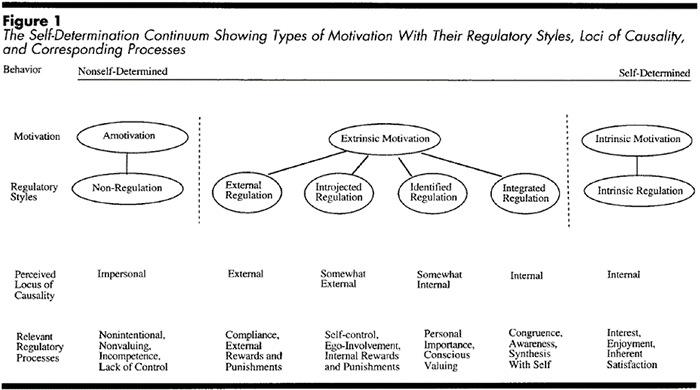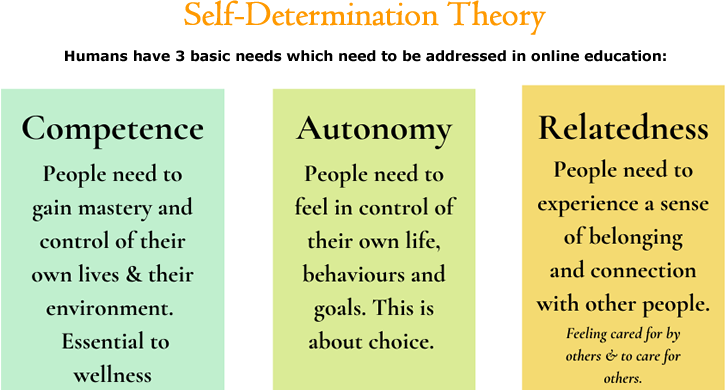How to deal with high drop-out rates in online education
Motivation for Online Learners:
Self-Determination Theory in Distance Education
By Richard Gallahad
The Puzzle – Retention Rates in Online Courses
My professional context is as an independent online educator, and my work includes both teaching Business English to Southeast Asian adult language learners (ASEAN Business English) and training teachers in how to design and deliver highly effective online courses (MisterBee – Online Course Delivery). My training is primarily delivered asynchronously via the virtual learning environment (VLE) Moodle and is complemented with regular synchronous, video conferencing.
In the early days of my training delivery, I found that learner motivation was usually high at the beginning of a course. Yet, motivation slumped as courses progressed, which was evidenced in lower levels of participation in discussion forums and the non-completion of tasks. On average, the completion rate for my training was 70%. This retention rate matches online courses researched in the literature (Willging and Johnson, 2004).
In terms of reasons given by learners for withdrawing from online courses, some are as should be anticipated with adult trainees. Changes in personal and professional life are unavoidable factors, which intervene in a learner’s ability to continue with their studies. Otherwise, the loss of ongoing motivation is a key factor.
It should be mentioned that in pre-course questionnaires and needs analyses from my course participants, extrinsic factors are almost always listed as the prime motivators for pursuing a course. Yet, in contrast, intrinsic motivation is widely understood to be of key importance in learners both completing a course and in their attaining deep learning (Hartnett, St George and Dron, 2011).
For this reason, as a course designer, I have previously sought to encourage intrinsic motivation in my learners.
The Theory – Self-Determination Theory (SDT)
Don’t ask how you can motivate other people. That’s the wrong way to think about it. Instead, ask how can you create the conditions within which other people will motivate themselves. And the answer, quite simply, is autonomy support (Deci, 2012)
Intrinsic motivation is an area that Edward Deci and Richard Ryan were exploring in the late 1970s. Intrinsic motivation is defined as “motivation where we do something just because it’s inherently interesting to us” (Ryan, 2015). Deci and Ryan were interested in what facilitates and what undermines intrinsic motivation. At the same time, they understood that most adult motivation is extrinsic, and wondered how they could help people become autonomous and volitional in the performance of actions that may not be inherently interesting or enjoyable. Their research showed that the conditions under which people became both intrinsically motivated and volitional in extrinsically orientated actions were related to the conditions that also promoted good health and a sense of wellness. This produced several theories on motivation and well-being, which are collectively known as Self-Determination Theory (SDT).
Motivation – the reason for acting in a particular way – can stem from an array of forces. It can come from the promise of a reward, the threat of punishment, or through personal belief. Central to SDT is the understanding that the quality of these prompts has a major effect on the ensuing behaviour.
In terms of extrinsic rewards and punishments, we are reminded of the classical theories of conditioning (i.e. Pavlov, Skinner). However, Ryan (2015), in reference to the ‘Skinner Box’, makes the point that human adults can decide to “leave the cage”. That is, if they lose interest in the rewards or reject the punishments, they will, where possible, withdraw from that environment. People have a choice. Therefore, SDT is also interested in why people make the choices they do, and how they can retain high levels of engagement while acting upon their choices, and under their own volition.
SDT focusses on two forms of volitional behaviour: intrinsic motivation and internalized motivation. These refer to whether we find something to be of interest to us and of value to us, respectively. SDT then asks what supports, and what hinders, these types of volition.
Underlying SDT is the broad conception that people have three basic psychological needs; the need for autonomy, competence and relatedness. While the theory covers a very wide spectrum, which it would be impossible to cover in this article, SDT stresses that the degree to which people are able to satisfy these three basic psychological needs is a critical issue in the effects of pursuing goals and attaining desired results (Deci & Ryan, 2000). Therefore, we shall consider these needs in isolation, and then explore how they can be satisfied in online course design.
Autonomy
Autonomy is the need to feel that the way in which one behaves in life is in accord with one’s own beliefs. An autonomous person self-endorses their actions, in contrast to people who feel controlled by regulation beyond their ability to change. Autonomy doesn’t necessarily imply the absence of external regulation. It implies the acceptance of regulation and its legitimacy. For example, most of us abide by traffic laws because we believe that they exist for the safety of ourselves and other road users. In following external directives, we are volitionally dependent. In other contexts, we may choose to follow our own agenda, in which case we are volitionally independent.
A point of interest in SDT is that extrinsic rewards are considered to be detrimental to intrinsic motivation. When people receive extrinsic rewards for following their own self-determined interests, they feel controlled by the reward and lose focus on their inner volition. Autonomy has been shown as essential to intrinsic motivation, with events such as threats, deadlines, and evaluation also undermining intrinsic motivation. Additional studies have indicated that these events inhibit creativity, complex problem solving, and deep learning (Deci & Ryan, 2000).
Competence
Competence is the need to feel in control of the things that matter in one’s life and to gain mastery of them. It is the need to feel effective in one’s environment. The satisfaction of the need for competence can arise both from a person’s own sense of achievement and from the acknowledgment of others.
Experiments in the 1970s showed that positive feedback from others enhanced intrinsic motivation more than a person receiving no feedback. Meanwhile, negative feedback had more of an adverse effect on intrinsic motivation than no feedback. These results were linked to the need for competence, in that positive and negative feedback signify whether a person is effective or ineffective. However, enhancement of intrinsic motivation from positive feedback has been observed to occur only when the individual feels responsible for their competence, or when feedback does not reduce their sense of autonomy (Deci & Ryan, 2000).
Competence applies both in extrinsic and intrinsic contexts. Extrinsically motivated learners may receive satisfaction of competence by passing a test or receiving a certificate. However, SDT suggests that a focus on such extrinsic rewards is a negative approach, which may entail people going through the motions to gain a reward, but not learning or developing at any deep level, and not finding any pleasure or satisfaction in their course of study. However, when competence and autonomy are united, intrinsic motivation is fostered, which has positive effects on a wider scale. Again, SDT research shows that the conditions under which people become intrinsically motivated are related to the conditions that also promote good health and a sense of wellness.
Relatedness
Relatedness is the need to feel a sense of belonging and connectedness with others. It is the need to feel valued by, and valuable to, other people within an environment.
Deci and Ryan (2000) find autonomy and competence to be the most powerful influences on intrinsic motivation but also regard relatedness as playing a significant role in its maintenance. For example, while observing children engaged in an interesting activity, they found that the children lost intrinsic motivation when joined by an adult who ignored the children’s attempts to interact with him. SDT asserts that a secure sense of relatedness causes intrinsic motivation to flourish.
Self-Regulation of Extrinsic Motivation
Now, there is a risk of Deci and Ryan’s ideas being taken as those of a rather fluffy, naïve ‘New Age’ philosophy. So, before our heads become lost in the clouds, let us ensure that our feet remain on firm ground. Certainly, the trinity of autonomy, competence, and relatedness brings inspiration to online course design, and a focus on deep learning and creative problem-solving are relevant to most areas of education. However, the suggestion that deadlines and assessments are negative is rather problematic in academic contexts and in courses geared toward certification. In the real world, learners need to meet deadlines and pass exams. In some scenarios, then, we cannot avoid the issue of extrinsic rewards, even while we understand that the pursuit of such may lessen individual growth and enjoyment.
It follows that Ryan and Deci (2000) became interested in how individuals acquire the motivation to pursue non-intrinsic practices and how this affects persistence, behaviour, and well-being. This developed into a sub-theory, called Orgasmic Integration Theory (OIT). In brief, this explores distinct types of extrinsic motivation and the contexts in which they are either promoted or hindered (see Figure 1).

SDT explains that when a person is required to act under the influence of an external factor, the response may be either unwillingness, passive compliance, or active commitment and that these reflect the varying degrees to which the value and regulation of the requested behaviour have been internalized and integrated. Internalization and integration entail that the need to pursue an act becomes linked with a sense of self. Ryan and Deci accept that behaviours that are uninteresting and values that are not adopted spontaneously are prescribed and expected in most settings, therefore SDT explores how non-intrinsically motivated behaviours can become self-determined, and how the social environment affects this.
From the former stance that extrinsic motivation is negative, SDT develops by considering that extrinsic motivation is variable in terms of autonomy. An example is given of two groups of students that are extrinsically motivated to do their homework. One group does so because they see the value of it in leading them to their goals; the other group does so due to parental control. The first group displays autonomy through personal endorsement and a sense of choice (Ryan & Deci, 2000).
For the individual, the autonomous integration and internalization of regulation is of key importance in the effective application of extrinsic motivation. But, to bring us back to the puzzle, we must now ask how the design of online courses, especially those with deadlines and formal assessment, can be geared towards facilitating our learners’ integration of extrinsic motivation.
OIT suggests that the main reason why people start to pursue uninteresting extrinsically motivated behaviours is because of a sense of relatedness with significant others who prompt, model, or value such behaviours. Therefore, learners feeling that they belong and are connected with others is essential for internalization.
Competence is also a factor, since when people feel that they are efficient at tasks that are valued by a group, this supports the internalization of extrinsically motivated activities.
Finally, autonomy is critical and must be supported by external regulation. Individuals need to understand the meaning of tasks and synthesize them with their own values and goals.
The Application of Theory in Online Course Design
Based upon the theory, I developed a checklist to ensure that all MisterBee courses are highly engaging and this has drastically reduced drop-out rates across the board. These key elements support ideas researched elsewhere ( see What is the importance of social presence in fostering deep learning?).
Autonomy
- Clarify learners’ needs/interests at the outset, and modify course content accordingly
- Allow a choice of different tasks
- Explain the aim of tasks and set clear goals
- Create learner-centred goals and achievements
- Where possible, make deadlines flexible
- Allow a choice of task response types, i.e. choice of format
- Cater for all learner types
- Be a facilitator, not a teacher … facilitate autonomous learning
Competence
- Begin every course with an Access & Setting to build confidence in using the virtual learning environment
- Ensure that tasks are achievable, although moderately challenging
- Provide positive feedback, and encourage positive peer feedback
- With quizzes, allow multiple attempts so that everyone can achieve 100%
- Include tasks that result in a practical application, relevant to students’ contexts
- Encourage critical thinking
- Use Moodle function to link task completion with competencies
Relatedness
- Online learners are likely to feel isolated, so focus on building a sense of community
- Begin courses with a Socialisation stage
- Build forum discussions into the tasks … ensure participation/engagement
- Include a mix of individual, pair, and group tasks
Facilitating Integration
- Make tasks flexible, so that participants can work on them in the context of their own academic/professional goals
- Model responses to forum posts, demonstrating validation, and make forum responses compulsory
So much for the theory … let’s experience it in practice …
“I felt so inspired by this course, which I learned so much from. It gave me a better perception of online teaching.”
Margo in South Africa
If you think ‘teaching online’ just means live lessons in a virtual classroom or Zoom, then get ready to think again!
Our comprehensive course on effective Online Course Delivery is now enrolling. Designed by industry experts with years of experience in online education, this course is tailored to help you develop and deliver effective, engaging online courses that inspire your learners and foster their success.
In this course, you will learn:
- The principles of effective online course delivery
- How to develop clear and measurable learning outcomes
- Strategies for engaging and motivating your learners
- How to design effective assessments and evaluations
- Tips for creating interactive and multimedia-rich content
- Techniques for promoting learner interaction and collaboration
- Best practices for managing online discussions and feedback
Our course is designed for educators and course creators of all levels, from beginners to experienced professionals. With a mix of online lectures, interactive activities, and real-world examples, you’ll gain the skills and confidence you need to create courses that truly make an impact.
Don’t miss out on this opportunity to take your online courses to the next level!
Enroll now and start delivering effective, engaging online courses that inspire your learners and drive their success!
Course length, dates & times
This 35-hour course is delivered over 5 weeks. There will be a weekly 1-hour live session, the timing of which will be negotiated per the availability of the group.
Apart from the live session, much of the interaction takes place in online forums. Participants can log in and work through each unit at any time during the week.
!! SPECIAL OFFERS !!
Book Online Course Delivery + Teaching Business English
and get £33 off the standard price
Register Now …
”I enjoyed Online Course Delivery immensely. The training provider has designed a detailed course that gives fantastic value for money, incorporating both individual and group forms of communication and tasks. The course has given me the knowledge and tools to further my career teaching online. I can highly recommend Online Course Delivery.”
Matt in Brazil
REFERENCES
Deci, E., 2012. Promoting Motivation, Health, and Excellence: Ed Deci at TEDx Flour City. Available at: https://www.youtube.com/watch?v=VGrcets0E6I [Accessed 6 June 2017].
Deci, E. and Ryan, R., 2000. The “What” and “Why” of Goal Pursuits: Human Needs and the Self-Determination of Behavior. Psychological Inquiry, 11(4), pp.227-268.
Hartnett, M., St George, A. and Dron, J., 2011. Examining Motivation in Online Distance Learning Environments: Complex, Multifaceted and Situation-Dependent. International Review of Research in Open and Distributed Learning, 12(6), pp.20-38.
Ryan, R., 2015. Facilitating Motivation and Wellness – Research and Insights from Self-Determination Theory. Available at: https://www.youtube.com/watch?v=wXFlT1kNbq8 [Accessed 7 June 2017].
Ryan, R. and Deci, E., 2000. Self-Determination Theory and the Facilitation of Intrinsic Motivation, Social Development, and Well-Being. American Psychologist, 55(1), pp.68-78.
Willging, P. and Johnson, S., 2004. Factors that Influence Students’ Decision to Dropout of Online Courses. Journal of Asynchronous Learning Networks, 8(4), pp.105-118.




